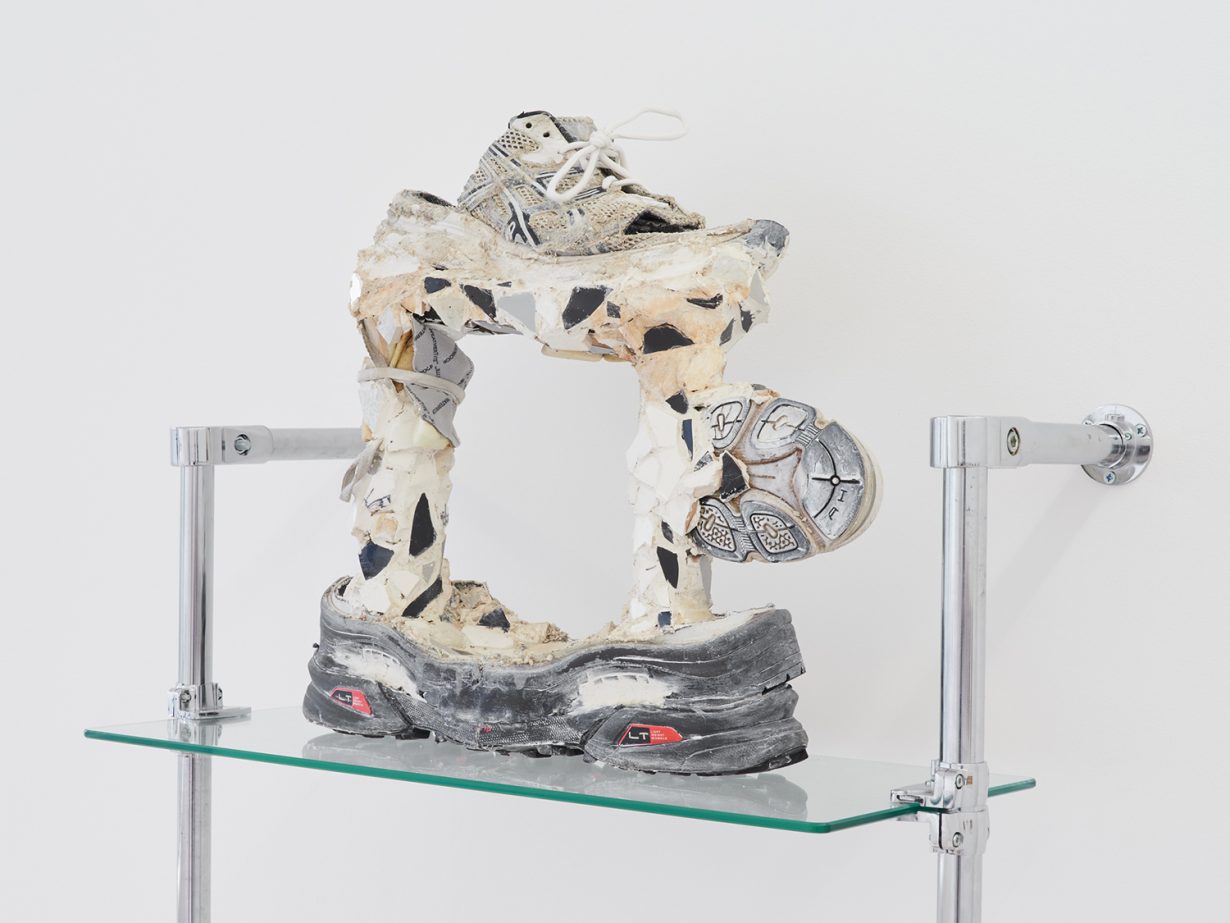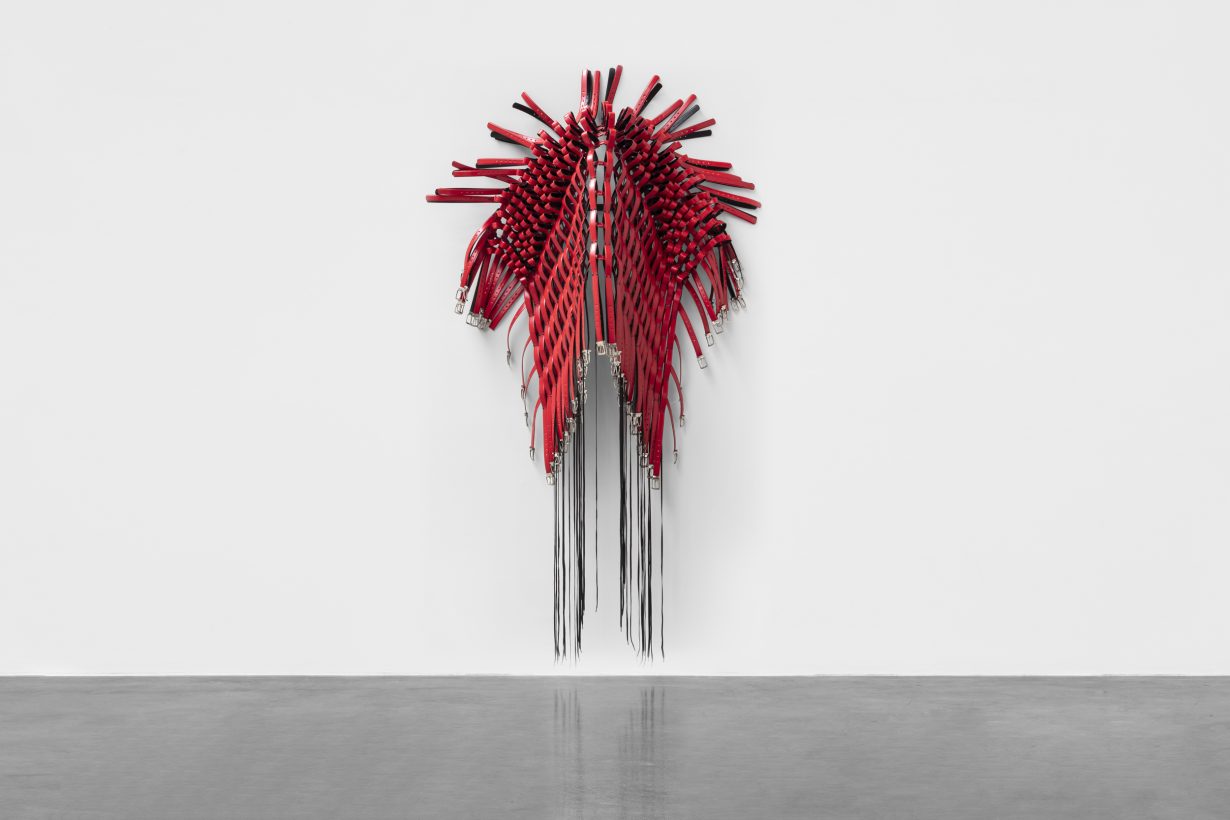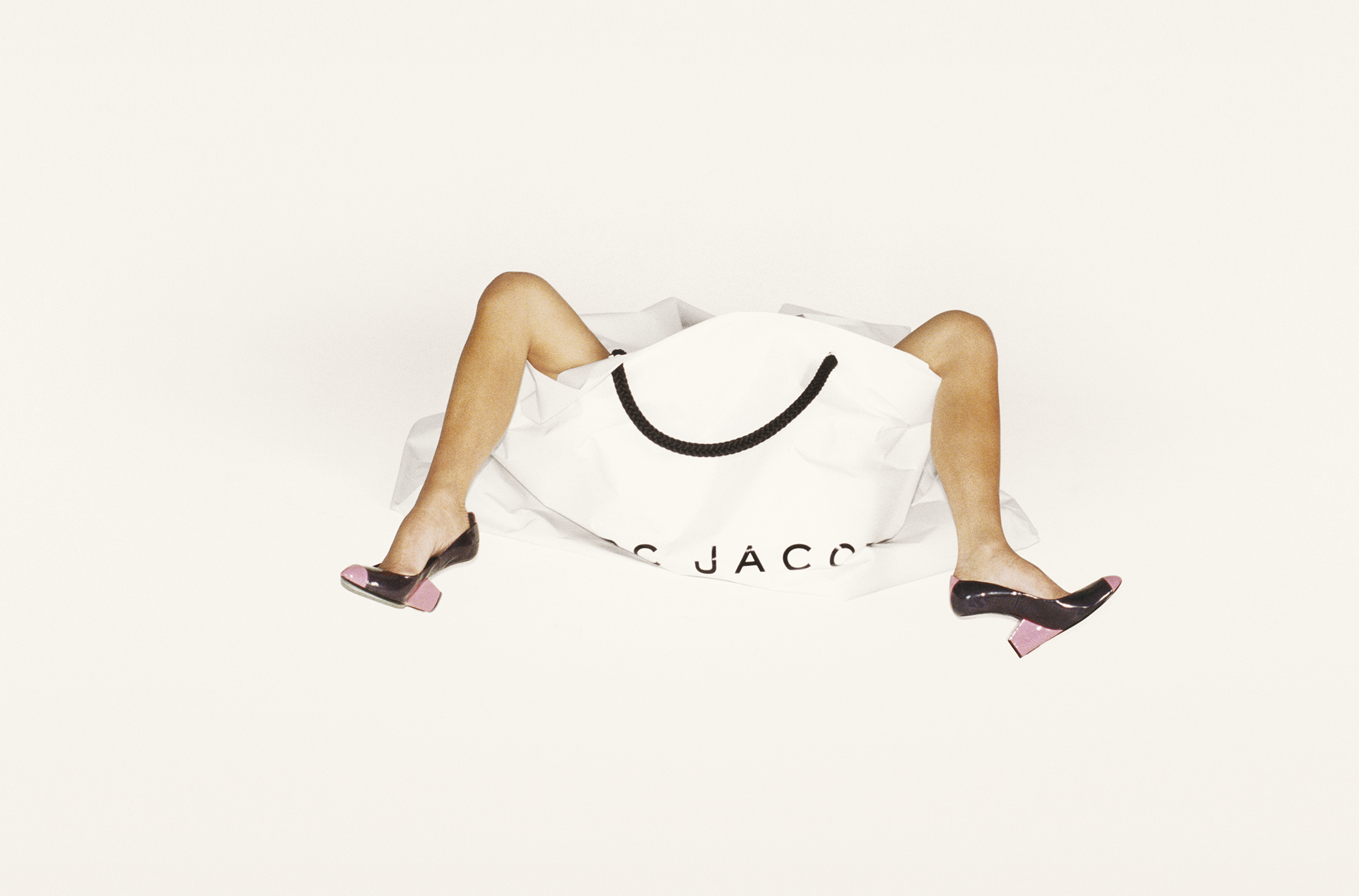Fashion gives art money, audience and cool. Art returns intellectual legitimacy. What is there to lose?
Sometimes the formula for success is simple: a visually arresting woman doing a strange thing. Snakes writhe around a model dressed head-to-armadillo-toe in Alexander McQueen. Victoria Beckham’s legs emerge akimbo from a giant Marc Jacobs shopping bag. A girl, shot by the now much-underrated Elaine Constantine, screams upside down on a swing in a red jumper. Linda Evangelista levitates on a steamy New York street. Joan Didion sits birdlike on an armchair, expression inscrutable behind her enormous Celine sunglasses.
This is the parade of models, actors, cultural icons and body parts that make up Beyond Fashion, an exhibition of fashion photography at London’s Saatchi Gallery (through 8 September). Curated by Nathalie Herschdorfer, it’s a rambling tour through contemporary fashion imagery (if we date contemporary back to about 1985), loosely arranged across six rooms under a series of labels including ‘fantasy’, ‘surrealism’, and, of course, ‘allure’. The predictable big hitters are there: the two photos of Linda and Joan mentioned above were taken by Peter Lindbergh and Juergen Teller respectively; and the exhibition also features Mario Testino, Nick Knight, Ellen von Unwerth, Koto Bolofo, Feng Li, to name a few. For an exhibition featuring over a hundred images, many – perhaps by a law of averages – are very good. But the categories are baggy and predictable, half-heartedly dealing with pitfalls like fashion’s obsession with thinness and youth before largely focusing on pictures of supermodels, with very little rationale as to why an image got popped in ‘fantasy’ rather than ‘surrealism’ or vice versa.
More ponderous is the insistence on a clean chronology in which fashion photography, once mired in the mucky world of commerce, has finally risen above its station to attain the status of art. ‘In the 21st Century, fashion photography is more than just a disposable picture, instantly forgotten,’ the first wall text declares. Pointing to the explosive rise of social media and its use in disseminating imagery, it goes on to claim that fashion photography is ‘no longer regarded as a frivolous medium’ – the editorials and adverts on display here transcending their initial marketing intentions to ‘create narratives that reach further than fashion’.

At first glance this feels like a curiously ahistorical claim: even the most cursory survey of earlier decades yields a trove of photographers whose work was entwined with and responsive to adjacent cultural movements. Take Man Ray’s surrealist fashion shoots, full of uncanny prop choices and mannequins masquerading as models, or Erwin Blumenfeld’s visual trickery with garments distorted by mirrors, veils and frosted glass. By the 1970s there was a whole subsection of fashion photography that achieved something closer to silent cinema, from Guy Bourdin’s macabre B-movie scenes to Deborah Turbeville’s haunted tableaus (Herschdorfer curated an excellent show of her work last year at Photo Elysée).
Indeed, fashion photography has always played the role of both thief and magician: ransacking other photographic genres, pinching from paintings, sculptures, theatre and film to conjure a dreamworld in which clothes become costumes for a different kind of life and desires are enacted or ominously twisted. These dreamworlds are built by many hands, requiring not only model and photographer but often stylists, hair and make-up artists, set designers, creative directors, editors, re-touchers and so on.
Read again, Beyond Fashion’s argument contains a trickier partial truth. Appreciation of fashion photography past and present has undoubtedly increased, but this isn’t just down to social media. Sure, platforms like Instagram and, increasingly, Twitter/X do a great job of resurrecting imagery and rerouting it to new audiences, Kate Moss by Corinne Day the face that launched a thousand archive accounts. They have also transformed the scope of reach for contemporary photographers, and, more importantly, for fashion brands with truly global audiences. But in doing so, these platforms have exacted a high price. What they offer in reach must be paid back threefold in volume. The machine is always hungry for more content, fashion imagery of all kinds – old, new, still, moving – blowing up and disappearing again at startling speed, more visible and more forgettable than ever before.
The bigger story here is that a once-overlooked corner of photography now enjoys not only the institutional exhibitions and expert critical commentary that confer real artistic gravity, but access to a different kind of commercial arena – the art market. When there are collectors who will happily shell out millions for a Richard Avedon or Helmut Newton to hang on the wall or store in a temperature-controlled vault, the needle doesn’t so much shift as leap, spinning merrily, on the perceived value and seriousness of the fashion image.
It is not the market that dictates what art is or isn’t, even if it can conjure fortunes and reputations along the way. The final and most generous reading, one which the exhibition touches on, is that we now understand the unique narrative space fashion photography at its best occupies: tapping into a strange and exhilarating part of the imagination, mirroring and distorting modern culture (at its worst, reinforcing a drearily narrow understanding of taste and beauty). But Beyond Fashion doesn’t quite find the heart of fashion photography’s alchemical appeal nor its tricksy mix of business and vision, its images too scattered, like hundreds of magazine spreads opened to random pages, to cohere.

Why might art and fashion have reason for wanting to share the same bed? Both are highly profitable industries for those at the top, who remain reliant on the exploitation of those at the bottom. Each thrives on a combination of perpetual novelty and valorising the dead. But they also possess qualities, or perhaps we can call them auras, that are useful to one another. Fashion, ever-changing creature that she is, likes to publicly justify her existence not by her shareholder value but her claims to artistry and visionary inspiration, her capacity to transform the wearer, fairytale-like, with a beautiful dress or must-have handbag. The artworld confers a useful legitimacy on her, a proximity – via the sponsorship of exhibitions and biennale pavilions, advertising in magazines such as this, or the opening of foundations, or the reproductions of artworks on jumpers, or the construction of an enormous Yayoi Kusama towering threateningly over Maison Louis Vuitton to publicise a collaboration with the brand – to the deeper cultural substance she may lack. In return, art is graced both with fashion’s conveniently deep pockets and a sprinkle of her glamour, or her cool, or the associated sheen of her household brand name recognition.
This is not to say that the two forms can’t be occasional co-conspirators. The odd designer, for example, earns the label ‘artist’ by dint of some special combination of conceptual rigour, wonder, needling subversion, sheer ingenuity, and/or ability to distil time and cultural preoccupation into wearable(ish) form. Alexander McQueen, whose clothes feature in Beyond Fashion, is frequently cited as one of the more nimble tightrope walkers between art and fashion, though Elsa Schiaparelli, Rei Kawakubo, Martin Margiela (who finally quit fashion for oil paintings and wigged sculptures), Hussein Chalayan and Iris Van Herpen would all suffice too. Other contemporary figures including Grace Wales Bonner and Jonathan Anderson work with and reference other artists with sufficient depth and regularity to make the results feel less like a cynical marketing tactic than a philosophy of creative cross-pollination – one which still manages to excite.
These are outliers in an increasingly bland fashion landscape, especially when it comes to the imagery and clothing being produced by luxury behemoths. McQueen, famously, worked for a period at Givenchy, while also maintaining his own label. The results might have been poorly received at first, but the room for risk-taking that he was given – the chance to experiment and get it wrong, to upset and bewilder people – now belongs to another age. Fashion has always cloaked its profit-making incentive under those claims of higher ideals, but now it is so potentially profitable, and so afraid of not achieving continual growth (Kering, who own McQueen, seem to be panicking after suffering a 10 per cent drop in profits in the first quarter of this year), with an ever-increasing gap between corporate-backed luxury labels and independent brands which are shuttering left and right, that the results are often desperately arid.
The artworld, too, does a fair amount of cloaking: investment and speculation and the sky-rocketing financial success of a series of ultra-contemporary artists justified by the perceived nobility of the form. Right now, this seems to have resulted in a lot of woozy abstract paintings (or worse, something described in every accompanying text as ‘abstraction meets figuration’), and perhaps a nagging sense, shared with the fashion world, of existential ennui about what it’s all for – where to find the pleasure and provocation, beyond making money and being seen at the right parties. Bedfellows in their anxieties as well as their mutual admiration and need, perhaps fashion and art are not so much clasping hands but clinging to each other in the dark.


Under these circumstances, there is something welcome in the current generation of artists who have chosen to plunder the world of fashion, staging their own smash-and-grabs of its materials and habits. Tenant of Culture’s Franken-textiles, of collaged garments and installations made from discarded clothing, probe at fashion’s excessive waste and encouragement to buy, buy, buy. Or there’s Bárbara Sánchez-Kane’s costumes, sculptures and films, so often reliant on surreal juxtaposition or canny sleight of hand: the assumed masculine power and nationalist symbology of a military uniform upended and splayed over a gallery’s white wall; dainty shoes constructed with cheese graters or miniature chairs in place of heels. Or even a label like Atelier E.B. produced by the designer Beca Lipscombe and artist Lucy McKenzie, who, like Sánchez-Kane, position themselves as simultaneous art project and clothing brand – displaying their wares in elaborate gallery installations whilst also making them available for purchase.
After all, it’s not like there is anything wrong with wanting to earn a living from what one makes – whether it’s a garment or a work of art. In fact, it is a necessity, or at least a precursor to a bigger question we aren’t yet ready to ask. But perhaps what an artist can do, and a designer may find it trickier to achieve, is address the hypocrisies and gross disparities of the industry in which they operate, the dominating logic of consumerism that has us all in its thrall.
Rosalind Jana is a culture, art and fashion writer.

